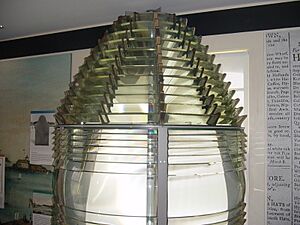Portland Head Light facts for kids
| Location | Portland Head off Shore Rd., Cape Elizabeth, Maine |
|---|---|
| Coordinates | 43°37′23″N 70°12′28″W / 43.62306°N 70.20778°W |
| Year first constructed | 1791 |
| Year first lit | 1791 |
| Automated | 1989 |
| Foundation | Natural emplaced |
| Construction | Rubble stone with brick lining |
| Tower shape | Conical |
| Markings / pattern | White with black trim |
| Focal height | 101 feet (31 m) |
| Original lens | Fourth order Fresnel lens (original), DCB 224 airport aerobeacon (current) |
| Range | 24 nautical miles (44 km; 28 mi) |
| Characteristic | Flashing white 4s Lighted continuously |
| Fog signal | HORN: 1 blast ev 15s |
Portland Head Light is a famous old lighthouse in Cape Elizabeth, Maine. It stands on a rocky point at the entrance to Portland Harbor. This harbor is a main shipping route in Casco Bay, part of the Gulf of Maine. Finished in 1791, it is the oldest lighthouse in Maine. Today, machines run the lighthouse. The United States Coast Guard takes care of the tower, light, and foghorn. The old house where the lighthouse keeper lived is now a museum. It is inside Fort Williams Park.
Contents
Building the Lighthouse
Construction of Portland Head Light started in 1787. George Washington, who later became the first U.S. President, ordered it to be built. It was finished on January 10, 1791. The project cost $1,500, which Washington also helped to set aside.
Early Lights and Lenses
At first, the lighthouse used lamps that burned whale oil to create light. In 1855, a special lens called a Fresnel lens was put in. This lens made the light much brighter and easier to see. Later, in 1958, an aerobeacon replaced the Fresnel lens. An aerobeacon is a powerful light, like those used at airports. In 1991, a newer DCB-224 aerobeacon was installed. This light is still used today.
Washington's Vision
In 1787, Maine was still part of Massachusetts. George Washington hired two builders, Jonathan Bryant and John Nichols. They were from Falmouth, which is now Portland. Washington told them to build the lighthouse. He reminded them that the new government didn't have much money. So, he said they should use materials found nearby, like stones from fields and shores. Oxen could easily pull these materials.
The first plans said the tower should be 58 feet tall. But when the builders finished, they realized it wasn't tall enough. Ships wouldn't be able to see it from far away. So, they added another 20 feet to the tower.
Finishing the Tower
The tower was made of rough stone. Washington gave the builders four years to complete it. In 1789, while the lighthouse was being built, the United States government was just forming. For a short time, it seemed like the lighthouse might not get finished.
However, the first U.S. Congress passed a law to fund the project. They told the builders to keep working. On August 10, 1790, Congress approved up to $1,500 more. They wanted the lighthouse to be finished under the President's direction. The tower was completed in 1790 and first lit on January 10, 1791.
Changes Over Time
During the American Civil War, ships sailing near Portland Harbor faced attacks. It became very important for ships to see Portland Head Light as soon as possible. Because of this, the tower was made 20 feet taller. The house where the lighthouse keepers lived was built in 1891.
Later, when another lighthouse called Halfway Rock Light was built, Portland Head Light was thought to be less important. In 1883, the tower was made 20 feet shorter. A weaker Fresnel lens was also put in. But sailors complained that the light wasn't strong enough. So, in 1885, the lighthouse was made taller again. The stronger Fresnel lens was also put back.
The lighthouse station has not changed much since then. In 1975, the building that held the foghorn was rebuilt. A storm had badly damaged it.
Today, Portland Head Light stands 80 feet above the ground. Its light is 101 feet above the water. The white, cone-shaped tower is connected to the keeper's house. The town of Cape Elizabeth owns the grounds and the keeper's house. The U.S. Coast Guard owns and maintains the light and fog signal. It helps ships navigate safely.
The lighthouse was added to the National Register of Historic Places on April 24, 1973. It was also named a National Historic Civil Engineering Landmark in 2002.
More to Explore


